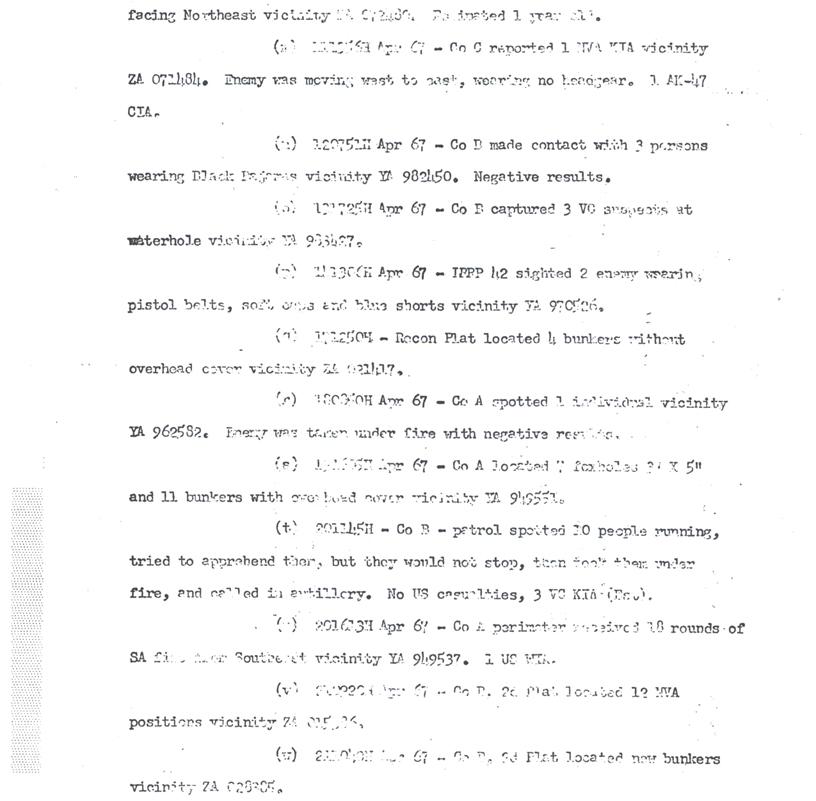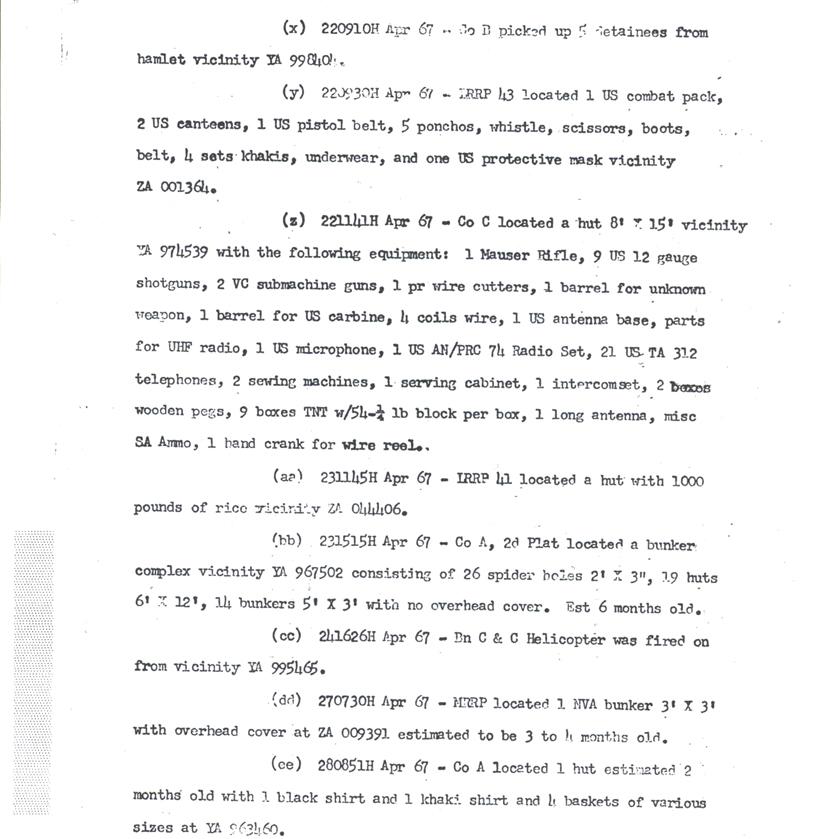![]() 1st Battalion 22nd Infantry
1st Battalion 22nd Infantry ![]()
OPERATION FRANCIS MARION
From April 6, 1967 through April 30, 1967 the 1st Battalion took part in
Operation Francis Marion.
|
Map of Operation Francis Marion The symbol for 2nd Brigade
As can be seen, 2nd BDE 4ID As the situation evolved, Map from: "Taking The
Offensive October 1966 |
The following passage describing Operation Francis Marion is taken from:
"Taking The
Offensive October 1966 to October 1967"
by George L. MacGarrigle, US Army Center of Military History 1998
The Highlands Again
The annual rains of the
southwest monsoon usually slowed the tempo of operations in the
western highlands. But in the spring of 1967
the soggy weather was not enough to stop the enemy command.
Beginning in May the 83 Front began a buildup aimed at drawing
the Americans back into the border areas, where prowling North
Vietnamese forces could attack them at will. Even after three
U.S. campaigns in the highlands in two years, the North
Vietnamese presence in the region was as strong as ever. In
addition to sapper,
artillery, and several independent North Vietnamese and Viet Cong
battalions, the 83 Front had no fewer than six main force
regiments
at its disposal. Three of those, the 32d, 66th, and 88th, all
familiar to American veterans of Operation SAM HOUSTON and
quickly back up to strength, belonged to the 1st PAVN Division
and were deployed in Cambodian Base Areas 701 and 702.
The remaining regiments were operating independently—the
24th in northern Kontum Province, the 958 in Pleiku Province,
and the 33d in northern Darlac. In midsummer a seventh regular
regiment, the 174th, joined the 24th in Kontum. Hanoi expected
the 63 Front to use those assets as it always had—to draw
the Americans away from the populated coast and into the rugged
border regions where it could inflict heavy casualties.1
The U.S. 4th Division remained
in the highlands to respond to any enemy incursion. It had just
completed SAM HOUSTON
in early April—just as the dry season ended—when
intelligence got an inkling of the North Vietnamese buildup.
Since the Americans
knew that all 83 Front units were still active, it was clear that
SAM HOUSTON had not caused the enemy too much pain.
Rain or shine, the border was a
dangerous place, so General Peers, the 4th Division commander,
decided to roll straight into a
new border campaign, for all practical purposes a continuation of
SAM HOUSTON, He called it Operation FRANCIS MARION,
and it kicked off on 6 April.
Peers was acutely aware of the
danger he faced. For the third time since its arrival in Vietnam
the previous year, the 4th Division
was guarding the border against North Vietnamese forays that
seemed to grow more dangerous each time. So, rather than simply
run operations along the border hoping to catch and bloody some
hapless main force unit, Peers decided to make FRANCIS MARION
a defense in depth.
He arrayed his 1st Brigade in an
arc twenty kilometers east of the Cambodian border along Route
I4B and the north-south line
of Special Forces camps running from New Plei Djereng to Duc Co
and down to Plei Me. Between this line and the border,
Special Forces, CIDG units, and the division's own long-range
reconnaissance teams searched for signs of the enemy. Behind the
line,
the 2d Brigade acted as a general reserve, ready to respond to
reports of significant North Vietnamese activity.
South Vietnamese Army units
extended the screen, with units of the 23d Division to the south
in Darlac Province and a
nondivisional South Vietnamese regiment, the 42d, to the north in
Kontnm Province. The 42d Regiment was split between
Kontum City, forty kilometers north of Pleiku City, and Tan Canh,
a village another forty kilometers farther north. Several U.S.
armor units backed the operation, as did the guns of I Field
Force's 52d Artillery Group at Pleiku, strengthened in March
by the newly arrived 1st Battalion, 92d Artillery (155-mm.
towed).
The 83 Front wasted no time in
implementing its plan. North Vietnamese activity increased
sharply in western Pleiku and
northern Darlac Provinces within days after Peers had initiated
FRANCIS MARION. Most of these contacts were small,
fleeting affairs. Then, in mid-April Special Forces teams
reported engaging a North Vietnamese battalion in northern
Darlac.
A few days later, near the Buon Blech Special Forces camp, some
seventy kilometers south of Plei Me, Special Forces
reported the presence of two Viet Cong companies. Peers responded
to this rash of sightings by sending a battalion task force
from the 1st Brigade into northern Darlac Province on 24 April.1
He then realigned his remaining forces—the 1st Brigade
with two battalions stayed along Route 14B, while Ihe 2d Brigade
with three battalions moved on line with the 1st Brigade
into positions south of Highway 19 and west of Plei Me in the la
Drang Valley.
As the 2d Brigade relocated, a
company from the 2d Battalion, 8th Infantry, a unit undergoing
conversion from straight-leg infantry
to mechanized, began a sweep north of Plei Me on 28 April. When
the armored vehicles ran into difficult terrain, the company
commander returned them to the battalion firebase. The company
continued the sweep for two days, ambushing a group of
North Vietnamese and killing thirteen. The rest fled, taking up
positions in a partially fortified camp. Unable to break through
the defenses, the Americans called for artillery and air strikes
and, later in the day, an Ml 13 scout platoon. All failed to
dislodge
what now appeared to be a full enemy company. The next morning
the attackers recalled the rest of their armored personnel
carriers
and were joined by two tanks from the division cavalry squadron.
But when they stormed the defenses, the enemy was gone.
Pushing on, the column ran into
another part of the enemy's base. When the armor attacked, the
North Vietnamese charged
from their bunkers, hurling grenades in a desperate attempt to
stop the oncoming tracks. It was a forlorn hope. Canister rounds
and machine-gun fire raked the North Vietnamese, and those who
came too close were crushed beneath the tracks. By late afternoon
the killing was over. One hundred thirty-eight North Vietnamese
soldiers of the 95B Regiment lay dead, while one American
had lost his life. The base yielded forty-two weapons and large
amounts of ammunition and equipment.
Afterward there was little
further evidence of enemy activity around Plei Me. But just to
the north, near Duc Co, an American
company repulsed a battalion-size attack on 1 May. A prisoner
captured during the action revealed that two of the 66th
Regiment's
battalions had recently entered South Vietnam and were building
base camps northwest of Duc Co. He also said that the 66th
planned to attack the Special Forces camp at Duc Co on 6 June,
before moving against Plei Me.
In the debris of its skirmish
with the 956 a few days earlier, the 2d of the 8th Infantry found
a notebook listing North Vietnamese
objectives for the rainy season offensive. The list included a
South Vietnamese district headquarters at Thanh An,
the 2d Brigade base at OASIS, and the Special Forces camps at New
Plei Djereng, Plei Me, and Duc Co.
A series of fire-fights south of Duc Co, the discovery of a
complex containing a radio that a North Vietnamese
battalion headquarters would use, and the interrogation of a
prisoner from the 1st PAVN Division provided further evidence
of a likely strike against the Special Forces camp.
The following are
excerpts from the original Operational Report
of 1st Battalion 22nd Infantry, filed on May 3, 1967.




**********************
The above Operational Report was submitted through the co-operation of Lou Talley and George Heidt.
Home | Photos | Battles & History | Current |
Rosters & Reports | Medal of Honor | Killed
in Action |
Personnel Locator | Commanders | Station
List | Campaigns |
Honors | Insignia & Memorabilia | 4-42
Artillery | Taps |
What's New | Editorial | Links |